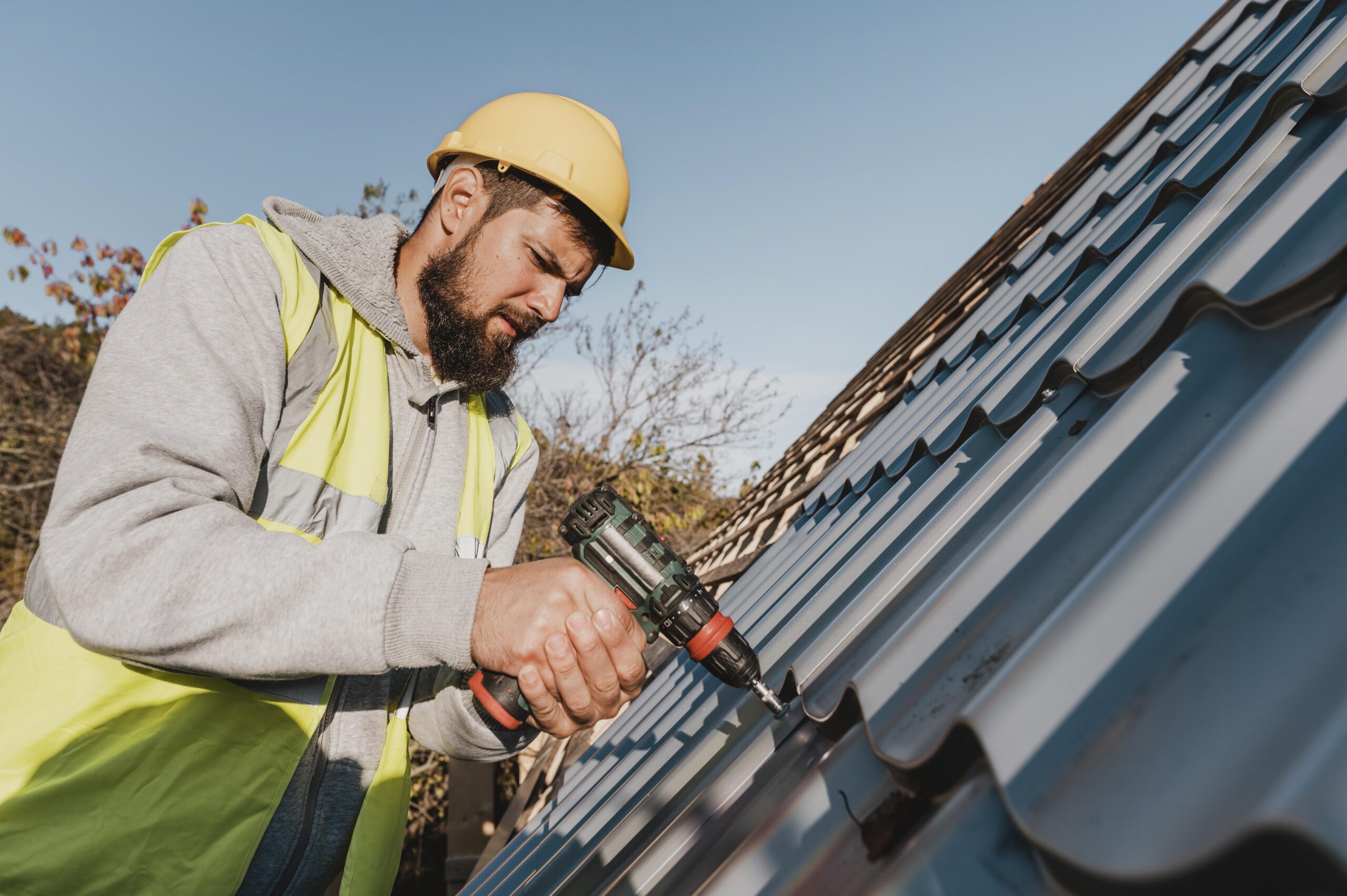Seasonal Roof Repair Work Checklist: Prepare Your Roofing System for each Weather Condition
By complying with a seasonal roof covering fixing checklist, you can remain in advance of potential problems. Allow's discover how correct maintenance can guard your home and extend your roof covering's life expectancy.
Examining Your Roofing for Wintertime Preparedness
As winter strategies, it's crucial to check your roof to verify it can stand up to harsh climate condition. Begin by looking for missing out on or harmed tiles; even a little problem can lead to considerable leaks when snow and ice accumulate. Next off, take a look at the blinking around smokeshafts and vents-- this area is frequently vulnerable to water intrusion.
Don't forget to search for indicators of sagging or unequal surface areas, as these might indicate structural troubles. Additionally, confirm your gutters are clear; clogged seamless gutters can bring about ice dams that damage your roofing.
 roof repair
roof repair
Spring Cleansing: Cleaning Debris and Checking for Damages
When winter season's hold releases, it's time to deal with springtime cleansing on your roofing by removing debris and looking for any kind of damage. Begin by checking your roof for dropped branches, leaves, and other debris that can trap wetness and cause rot. A clean roof promotes far better water drainage and stops mold growth.
Next, get hold of a tough ladder and thoroughly check shingles for splits or missing out on items. Take notice of areas around vents and chimneys, as these places are prone to leaks. Do not neglect to examine your rain gutters, ensuring they're devoid of obstructions that could result in water pooling.
While you're up there, try to find signs of wear, like rust on metal blinking or loose seals around skylights. Addressing them now can save you from costly repair services later on if you find any kind of concerns. A little spring cleansing goes a long way in maintaining your roof's stability.
Summer Season Heat: Examining Your Roof Covering for Heat-Related Issues
As summertime heat magnifies, it's vital to check your roofing for heat-related issues. Look for any type of tile damage, seek indications of warm fastening, and review just how well https://jimplacknews.com/ll-roofing-delivering-excellence-in-roofing-solutions-for-gainesville-and-beyond/ your roofing ventilates. Taking these steps now can prevent larger problems down the roadway.
Check for Tile Damage
 roof repair
roof repair
Look For Warm Buckling
Warmth buckling is a common concern that can occur during the scorching summer season, and it's vital to check for it on your roof. As temperatures rise, roof products, particularly asphalt roof shingles, can broaden and agreement. This motion can result in warping, producing unattractive lumps or fractures. Start by checking your roofing system aesthetically; try to find any type of unequal surfaces or raised sides. Pay unique focus to areas around chimneys and vents, where fastening is most likely to take place. It's vital to address them immediately to stop more damages if you identify any type of signs of warmth fastening. If you're not sure concerning the extent of the problem or how to repair it effectively., consider speaking with an expert.
Examine Roof Ventilation Effectiveness
After checking for warm fastening, it is necessary to examine your roof's air flow efficiency. Appropriate ventilation helps manage temperature level and moisture, stopping damage from too much warmth. Start by evaluating your vents; make certain they're not obstructed by debris or insulation. Seek indicators of poor air movement, like heat build-up in your attic room or warped roof products. You might likewise intend to inspect if your soffit vents and ridge vents function together properly. If your home feels stale and overheated, take into consideration updating to more reliable ventilation systems, like powered attic fans or added soffit vents. Keep in mind, preserving excellent ventilation not just extends your roofing's life however also enhances your home's general energy performance, ensuring comfort throughout those warm summer season.
Rainy Period Preparedness: Making Sure Correct Drain
As the wet period techniques, you need to ensure your roof's water drainage system is all set to deal with heavy downpours. Beginning by examining your rain gutters and downspouts, and see to it they're clear of debris. Do not neglect to inspect the flashing and seals to stop leaks and water damages.
Evaluate Gutters and Downspouts
Start by examining for any type of visible particles, like leaves or branches, that might block the circulation of water. Next off, take a look at the downspouts for blockages or damages; a blocked downspout can cause water to overflow, possibly damaging your roofing system and foundation. If you detect any issues, address them promptly to prevent expensive repairs.
Tidy Roofing Surface Area Debris
Use a roof covering rake or broom to delicately remove particles, being careful not to damage the roof shingles. After cleansing, monitor your roofing system after heavy rains to find any type of prospective concerns early. Keeping your roofing clear of particles is important for preventing pricey repair services down the line.
Inspect Flashing and Seals
After removing your roof of particles, take a closer look at the flashing and seals around vents, chimneys, and skylights. If you notice any kind of damage, it's essential to repair or change it immediately. Guaranteeing these elements are in good problem will assist keep proper drainage and safeguard your home from water damages throughout heavy rains.
Checking and Preserving Roof Covering Seals and Flashing
While it may appear simple to neglect, checking and preserving roof covering seals and blinking is essential for avoiding leakages and water damages. Beginning by checking the seals around smokeshafts, vents, and skylights. Look for any fractures, spaces, or signs of wear. It's finest to reseal them with proper roofing sealer to guarantee a limited fit. if you find any kind of problems.
Following, analyze the blinking, which directs water away from crucial areas. Inspect for corrosion, loosened sections, or bent sides.
Finally, don't forget to wipe any type of particles that might block the seals or blinking. Maintaining these parts in excellent form will certainly aid safeguard your roof covering against the components and prolong its life-span.
Gutter Upkeep: Keeping Water Moving Efficiently
Given that your rain gutters play an essential role in routing rain away from your home, normal maintenance is crucial for preventing water damages and foundation concerns. A clogged seamless gutter can lead to water overflow, which may harm your roofing and home siding.
If you notice any type of damage, repair service or change the affected components immediately. Confirm downspouts are directing water at least 6 feet away from your foundation.
Finally, examine that your gutters are effectively sloped, preferably a quarter inch for every 10 feet. This slope warranties water flows efficiently toward the downspouts. Routine upkeep will maintain your seamless gutters operating effectively and protect your home from pricey fixings.
Scheduling Specialist Examinations for Comprehensive Treatment
Routinely organizing expert inspections is important for keeping your roofing system's integrity. These specialists can spot prospective issues before they develop into costly repairs. Purpose for a minimum of 2 assessments a year-- one in the springtime and another in the loss. This timing enables you to address any damages brought on by wintertime weather or summertime tornados.
Throughout examinations, professionals will assess roof shingles, flashing, and ventilation, guaranteeing every little thing's in leading shape. They'll additionally look for indicators of wear, leakages, or mold and mildew, which you could forget. Setting up these evaluations not only prolongs your roofing system's lifespan however also offers you satisfaction.
If you're uncertain concerning the problem of your roofing, do not wait to call a professional. Investing in these check-ups currently can conserve you a whole lot later on. Prioritize your roof's health, and you'll be well-prepared for whatever weather comes your way.
Frequently Asked Inquiries
How Usually Should I Inspect My Roofing Throughout the Year?
You ought to examine your roof covering a minimum of two times a year, preferably in spring and fall. After serious weather condition occasions, check for damages as well. Routine examinations help you capture problems early and conserve money on fixings.
What Indicators Suggest I Need a Roof Covering Replacement Instead of Repair Service?
 roof repair
roof repair
Can I Do Roof Covering Fixes Myself, or Should I Work with a Professional?
You can do small roofing system repairs yourself if you're comfortable with elevations and fundamental devices, however employing a specialist warranties safety and security and appropriate job. Do not take the chance of damages; it could be worth the investment for assurance.
What Are the most effective Materials for Roof Covering Repair Works in Different Environments?
For various climates, you'll want products like asphalt roof shingles for modest locations, steel roof covering for extremes, and clay floor tiles for hot regions. Always think about regional climate patterns to ensure your roofing system withstands the elements effectively.
Exactly How Do Roof Covering Guarantees Influence Seasonal Maintenance Responsibilities?
Roof covering warranties commonly define maintenance obligations, so you'll need to evaluate the terms. If you do not maintain your roof covering as needed, you might void the warranty, leaving you responsible for costly repair work.
Seasonal Roof Covering Fixing Checklist: Prepare Your Roof for Every Weather
When winter months's grasp releases, it's time to take on springtime cleaning on your roof by getting rid of away debris and examining for any kind of damages. Inspect for any kind of roof shingles damage, look for indications of warmth fastening, and examine just how well your roof covering ventilates. If you find any problems, take into consideration calling a specialist for fixings to maintain your roof in top shape and shield your home from prospective water damage.
While it may seem very easy to ignore, examining and keeping roofing system seals and flashing is vital for preventing leaks and water damages.